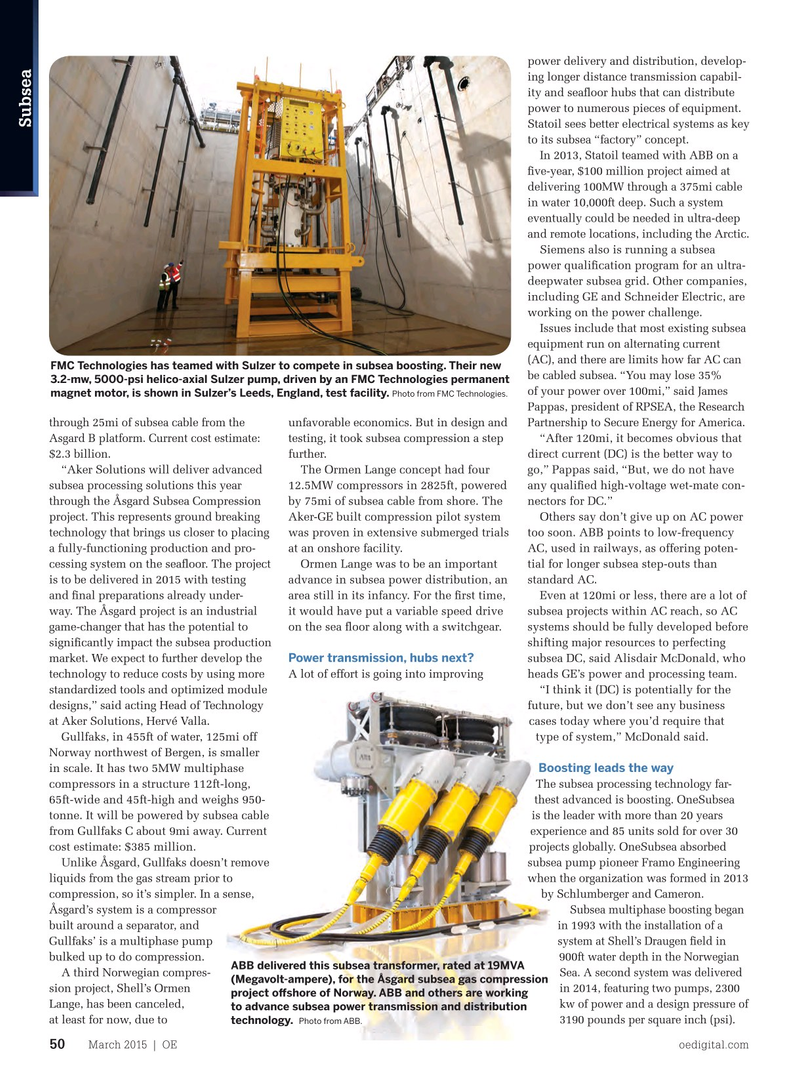
Page 48: of Offshore Engineer Magazine (Mar/Apr 2015)
Read this page in Pdf, Flash or Html5 edition of Mar/Apr 2015 Offshore Engineer Magazine
power delivery and distribution, develop- ing longer distance transmission capabil- ity and sea? oor hubs that can distribute power to numerous pieces of equipment.
Subsea
Statoil sees better electrical systems as key to its subsea “factory” concept.
In 2013, Statoil teamed with ABB on a ? ve-year, $100 million project aimed at delivering 100MW through a 375mi cable in water 10,000ft deep. Such a system eventually could be needed in ultra-deep and remote locations, including the Arctic.
Siemens also is running a subsea power quali? cation program for an ultra- deepwater subsea grid. Other companies, including GE and Schneider Electric, are working on the power challenge.
Issues include that most existing subsea equipment run on alternating current (AC), and there are limits how far AC can
FMC Technologies has teamed with Sulzer to compete in subsea boosting. Their new be cabled subsea. “You may lose 35% 3.2-mw, 5000-psi helico-axial Sulzer pump, driven by an FMC Technologies permanent of your power over 100mi,” said James magnet motor, is shown in Sulzer’s Leeds, England, test facility. Photo from FMC Technologies.
Pappas, president of RPSEA, the Research through 25mi of subsea cable from the
Partnership to Secure Energy for America.
unfavorable economics. But in design and
Asgard B platform. Current cost estimate: testing, it took subsea compression a step “After 120mi, it becomes obvious that $2.3 billion.
further. direct current (DC) is the better way to
The Ormen Lange concept had four “Aker Solutions will deliver advanced go,” Pappas said, “But, we do not have 12.5MW compressors in 2825ft, powered subsea processing solutions this year any quali? ed high-voltage wet-mate con- by 75mi of subsea cable from shore. The through the Åsgard Subsea Compression nectors for DC.”
Aker-GE built compression pilot system project. This represents ground breaking Others say don’t give up on AC power was proven in extensive submerged trials technology that brings us closer to placing too soon. ABB points to low-frequency at an onshore facility. a fully-functioning production and pro- AC, used in railways, as offering poten-
Ormen Lange was to be an important cessing system on the sea? oor. The project tial for longer subsea step-outs than advance in subsea power distribution, an is to be delivered in 2015 with testing standard AC.
area still in its infancy. For the ? rst time, and ? nal preparations already under- Even at 120mi or less, there are a lot of it would have put a variable speed drive way. The Åsgard project is an industrial subsea projects within AC reach, so AC on the sea ? oor along with a switchgear. game-changer that has the potential to systems should be fully developed before signi? cantly impact the subsea production shifting major resources to perfecting
Power transmission, hubs next?
market. We expect to further develop the subsea DC, said Alisdair McDonald, who
A lot of effort is going into improving technology to reduce costs by using more heads GE’s power and processing team.
standardized tools and optimized module “I think it (DC) is potentially for the designs,” said acting Head of Technology future, but we don’t see any business at Aker Solutions, Hervé Valla. cases today where you’d require that
Gullfaks, in 455ft of water, 125mi off type of system,” McDonald said.
Norway northwest of Bergen, is smaller
Boosting leads the way in scale. It has two 5MW multiphase
The subsea processing technology far- compressors in a structure 112ft-long, thest advanced is boosting. OneSubsea 65ft-wide and 45ft-high and weighs 950- is the leader with more than 20 years tonne. It will be powered by subsea cable experience and 85 units sold for over 30 from Gullfaks C about 9mi away. Current projects globally. OneSubsea absorbed cost estimate: $385 million.
subsea pump pioneer Framo Engineering
Unlike Åsgard, Gullfaks doesn’t remove when the organization was formed in 2013 liquids from the gas stream prior to by Schlumberger and Cameron. by Schlumberger and Cameron. compression, so it’s simpler. In a sense,
Subsea multiphase boosting began
Åsgard’s system is a compressor in 1993 with the installation of a built around a separator, and system at Shell’s Draugen ? eld in
Gullfaks’ is a multiphase pump 900ft water depth in the Norwegian bulked up to do compression.
ABB delivered this subsea transformer, rated at 19MVA
Sea. A second system was delivered
A third Norwegian compres- (Megavolt-ampere), for the Åsgard subsea gas compression in 2014, featuring two pumps, 2300 sion project, Shell’s Ormen project o

 47
47

 49
49